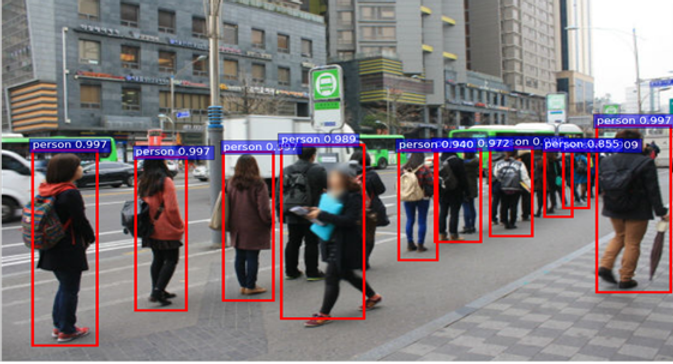
Deep Learning
Deep learning is a branch of machine learning based on a set of algorithms that attempt to model high-level abstractions in data by using model architectures, with complex structures or otherwise, composed of multiple non-linear transformations.
Figure1 shows one of deep learning architectures, CNN(convolutional neural network).

● Classification
Current approaches to classification make essential use of deep learning methods.
Classification using deep learning can detect what and who is on a picture. In addition, classification detects objects which humans cannot even identify and combine these results to create a perfect representation of an image.

“Siberian husky” “Eskimo dog”
● Object Detection
In recent days, many applications using deep learning are top issues in IT industry. Object detection method using deep learning architecture takes an image as an input and the output shows not only objects in the image but also their locations.

Recently, deep convolution neural networks have significantly improved image classification and object detection accuracy. Compared to image classification, object detection is a more challenging task that requires more complex methods to solve. Faster R-CNN builds on previous work to efficiently classify object proposals using deep convolutional networks. Using this network, we applied for pedestrian and text detection.

Pedestrian detection

Text detection
● Medical Image Classification
Using VGG 16 network, which is one of the most popular networks for classifying image. (The network won second place on ImageNet ILSVRC 2014 competition.) It has enough layers and parameters for finding features in large complex images.
We use pre-trained parameters trained on ILSVRC classification task before fully connected layers, therefore we can get feature vectors for each image. Each image turns into 4096 length feature vectors and pass through one hidden layer and output layer for classifying the image belongs to normal or abnormal.
We trained with 17255 CT images consist of 6917 for normal and 10338 for abnormal. After training, we test with 6200 CT images and it shows 80% accuracy.

● Recurrent Neural Networks
Recurrent neural network (RNN) is a network of neurons with feedback connections. It can learn many behaviors like sequence processing tasks, algorithms, programs that are not learnable by traditional machine learning methods. They are computationally more powerful and biologically more plausible than other adaptive approaches such as Hidden Markov Models, feedforward networks and Support Vector Machines.

Our applications using RNNs are classification of sequential images, read and comprehending system, joint with CNN, and generating sequences or images.



● Forecasting (Finance)
There are many attempts to analyze stock market using mathematical, statistical, or computational methods. Usually linear models are used to representing stock market, and for non-linear models machine learning method can be used.
However, as you expected, stock market is one of the most complex models and much information should be concerned to analyze and predict the future movement. In machine learning method, there is only shallow (actually one) layer, so it cannot represent complex relationship. To overcome this limit, sometimes they use kernel function, as the function is given by well-known function, but the potential of the method is restricted.
In deep learning method, we can stack enough layers that consists of many neurons to represent complex relationship by composition of many non-linear functions. So we can efficiently analyze stock market with deep learning model and also can predict how it varies.
We are developing stable and high return models for stock market, using various deep learning methods such as CNN or RNN. We treat both Korea stock market (KOSPI or KOSDAQ) and U.S. stock market (NASDAQ).
